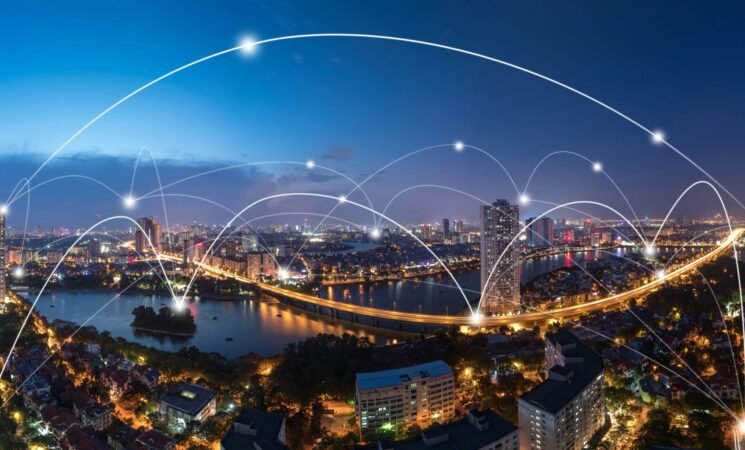4 September 2025, NIICE Commentary 11802
Afridi Ahmed & Mohammad Taha Ali
The Indo-Pacific has become the center of gravity in 21st-century geopolitics, not only because of its maritime trade routes and strategic chokepoints, but increasingly because of its digital architecture. The competition for cables, cloud, and 5G infrastructure is now a central site of great-power rivalry. As states compete for dominance over the data highways of the future, digital connectivity has outgrown its technical nature; it is now a factor of sovereignty, economic competitiveness, and national security. In this dynamic, the Indo-Pacific is both the laboratory and the battlefield for competing digital orders. China’s “Digital Silk Road” (DSR) seeks to weave a Sino-centric web of technology and influence, while the United States and its partners promote a model based on openness, trust, and transparency.
The Indo-Pacific Digital Landscape
The Indo-Pacific’s digital landscape features remarkable diversity and inequality. It includes advanced digital economies such as Japan, South Korea, Singapore, and Australia, alongside developing states like Cambodia, Myanmar, and Papua New Guinea. The region is home to over half of the world’s internet users, yet deep divides persist between urban and rural areas, and between maritime and island nations.
The region’s digital infrastructure depends on tens of thousands of kilometers of undersea cables carrying over 95 percent of global data traffic. These cables are increasingly regarded as strategic assets vulnerable to espionage, sabotage, and geopolitical coercion. Meanwhile, the rollout of 5G networks and the rapid growth of data centers are redefining connectivity. While private firms such as Google, Meta, and NTT play leading roles, state-backed initiatives—particularly from China—have added new political dimensions.
Strategic Drivers of Digital Connectivity
Three strategic imperatives drive the Indo-Pacific’s digital boom. The first is economic transformation. Digital trade, e-commerce, and fintech have become central to post-pandemic recovery and global competitiveness. Governments now view digital infrastructure with the same importance once given to ports or highways, recognizing it as the backbone of modern growth. The second imperative is security and resilience. The pandemic and global supply chain disruptions exposed the risks of technological dependence, pushing states to build secure, diversified, and redundant digital systems that can withstand cyber threats and political coercion. The third is strategic competition. As the United States and China vie for technological supremacy, the Indo-Pacific has emerged as a key arena of contestation. Countries from Indonesia to Vietnam are carefully recalibrating partnerships to avoid overreliance on any single provider, while regional groupings such as ASEAN and the Quad emphasize interoperability and trusted technologies to ensure a stable and open digital ecosystem.
China’s Digital Silk Road in the Indo-Pacific
The Digital Silk Road (DSR) represents Beijing’s effort to expand its technological and normative footprint in the Indo-Pacific. Through investments in submarine cables, 5G networks, satellites, and e-commerce platforms, China has positioned itself as a major enabler of digital modernization for emerging economies. Companies such as Huawei, ZTE, and China Mobile lead this outreach, offering competitive rates and concessional financing that few Western competitors can match.
The DSR carries strategic implications. It allows China to shape data governance norms, access critical information flows, and deepen political ties with host states. For developing countries, it offers modernization and affordability—but at the potential cost of dependence and exposure to digital authoritarian practices.
The US and Allies’ Counter Strategies
To counter China’s expanding DSR, the United States and its allies have adopted multi-faceted strategies promoting “trusted digital infrastructure.” The Indo-Pacific Economic Framework for Prosperity (IPEF), launched in 2022 with 14 partners, aims to set standards for digital trade, cross-border data flows, and cybersecurity, emphasizing inclusiveness and resilience rather than traditional free trade.
Frameworks like the Quad (US, India, Japan, and Australia) address technology dependency, supply chain fragility, and competition over AI. The Quad’s Critical and Emerging Technologies Working Group coordinates efforts on 5G, semiconductors, AI, and biotechnology. Japan and Australia have also begun financing undersea cable projects across the Pacific islands, connecting Palau to trans-Pacific networks as alternatives to Chinese-backed systems.
Challenges in Building Digital Connectivity
Despite progress, the Indo-Pacific faces steep hurdles. Infrastructure gaps persist due to the pandemic’s economic toll and difficult geography. For low-income states like Papua New Guinea, Timor-Leste, and Cambodia, building fibre networks and undersea cables remains prohibitively expensive.
Regulatory fragmentation, uneven data protection laws, cybersecurity standards, and taxation policies erode investor trust and complicate cross-border data flows. ASEAN and Australia’s regional frameworks address parts of the problem but fall short of harmonization.
Cybersecurity threats from both state and non-state actors further hinder progress. Chinese cyber operations have targeted digital infrastructure and democratic systems. Undersea cables, carrying 99 percent of Australia’s data, remain particularly vulnerable. A coherent, democratic regional framework for digital infrastructure security is thus urgently needed.
Future Outlook: Opportunities and Risks
The Indo-Pacific’s digital transformation presents both significant opportunities and pressing risks. On the opportunity side, the expansion of digital connectivity through new undersea cables—such as Google’s Darwin project—promises to diversify data routes and enhance the region’s overall network resilience. The growth of fintech and artificial intelligence has also positioned the region, led by China and India, as a global hub for digital innovation and entrepreneurship. Moreover, tech diplomacy is emerging as a key avenue for cooperation, with multilateral frameworks like the Quad and ASEAN working to promote secure, transparent, and interoperable telecommunications ecosystems.
However, these gains are tempered by critical risks. A looming Cold War–style fragmentation threatens to divide the digital world into rival technological blocs, as competing U.S. and Chinese systems erode interoperability and create geopolitical fault lines. Additionally, infrastructure vulnerabilities persist across the region, with financing shortfalls, escalating cyber threats, and weak regulatory frameworks leaving many states exposed to instability and coercion.
Conclusion
The evolution of digital connectivity in the Indo-Pacific reflects the broader geopolitical transformations shaping the region. What began as a drive for modernization has become an arena of great-power rivalry. China’s Digital Silk Road and US-led counter-strategies illustrate both the promise and peril of the digital age.
For Indo-Pacific nations, the central challenge is to balance opportunity with autonomy—welcoming investment while safeguarding sovereignty and cyber resilience. As fibre-optic cables and data centers become instruments of power, the contest for digital dominance is, in essence, a contest over the very character of the regional order.
Yet, this contest is not merely between Beijing and Washington. Middle powers—India, Japan, Australia, and South Korea—are emerging as digital shapers in their own right. India’s Digital Public Infrastructure model, for instance, demonstrates that innovation and inclusion can coexist with strategic autonomy. Japan’s leadership in undersea cables and Australia’s cybersecurity initiatives offer regional public goods that reinforce an open, secure, and interoperable network.
Going forward, the Indo-Pacific’s digital future will depend on how effectively regional states cooperate to build resilient infrastructure and shared governance norms. The path toward a stable digital order lies in collective capacity-building, transparency, and diversification. If these countries succeed, the Indo-Pacific could pioneer a model of connectivity rooted in openness and trust rather than control and dependency.

